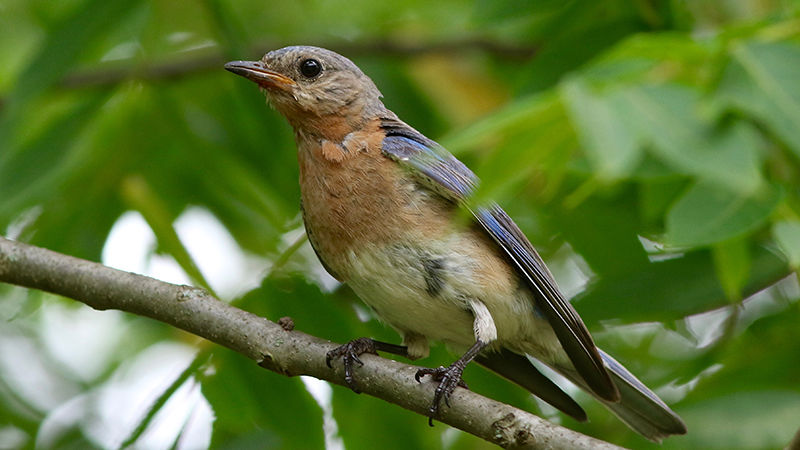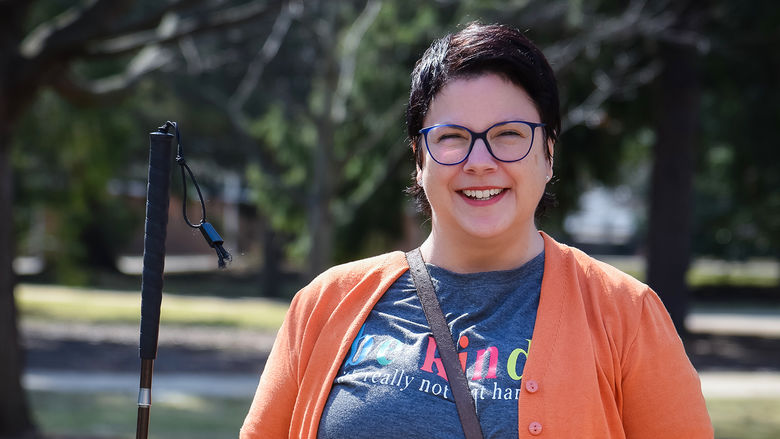

This dialog contains the full navigation menu for this site.

Each spring and fall birds migrate, heading for food and a more hospitable climate. Those migrations are an ideal time for humans to take stock of bird populations, to compare one year’s numbers to years past, as a measure of species’ health and possible changes in the environment. One way to measure the number of birds is by holding “bird count” events. For the second year in a row the Earth Day Birding Classic was held at Penn State Altoona as teams competed to identify by sight or sound as many species of birds as possible in 24 hours in Blair and nearby counties.
Penn State Altoona 2016 alumna Catie (Kilgus) Farr and her husband, Ethan Farr, again organized the event with Penn State Altoona’s Assistant Professor of Earth Science Mark Bonta, and Laura Jackson and Jake Vaughn of the Juniata Valley Audubon Society (JVAS). Farr is very pleased to see the event grow from last year. “We had seven teams compete this year — one more than last year — and two student teams, so that was really cool,” she said.
Always looking for ways to improve the Classic, organizers made a few changes to this year’s competition. “We added a new category from last year, named ‘Flicker,’ for our ‘Big Sit’ category,” Farr explains. “Participants of this category are required to sit in one spot for the 24-hour classic and count the number of species of birds they can see from that one area.”
Results were impressive. Top among the competitors was the “Beards and Birds” team, which won the grand prize for counting 103 species.
This year there not only were more participants, but more money raised — a nearly $400 increase from the event's inaugural year for JVAS and the Sustainability Council. “We are very excited about funding new projects with that $1,630 raised,” Farr says. And she’s already looking to next year’s competition. “Every year we are just looking to raise a little more money and awareness, and have a few more participants. I have no double this will catch on in the next few years and really take off.”
The funds from the first Classic went to good use, Farr reports. “Last year we raised a total of $1,245.50 that was split between JVAS and Penn State Altoona’s Sustainability Council.” The money was divided between two research projects, one for reclaiming wetlands and the other a bluebird study at Canoe Creek State Park led by Laura Palmer, associate professor of biology at Penn State Altoona.
Environmental studies 2017 graduate Angela Spagnoli, is utilizing funds from the JVAS as she works to reclaim a wetlands site in Blair County. She describes both her project and her motivation:
“I wanted to find a neglected wetland area and create a healthier, more functional habitat, not only for the inhabiting species, but also for community outreach," said Spagnoli. "I was told about an area behind the Northern Blair County Recreation Center in Tipton, which was previously used for wetland demonstration. Dr. Jim Julian accompanied me to first assess the area and I realized this place is filled with biodiversity, including the highly threatened Jefferson salamander. It’s a six-hectare [nearly 15 acres] wetland, consisting of vernal pools (seasonally flooded) and year-round inundated pools — making it a vital ecosystem for many amphibian and reptile species, plants and birds. The Board of Directors at the Rec Center was very excited and supportive when hearing my ideas.
“I’m going to remove the invasive species, mainly focusing on multi-flora rose, invasive honeysuckle, privet and Japanese knotweed. I’ve received donations from Seed-balls, a local company, who gave me several obligate and facultative wetland plant species. Once the invasives are removed, I will replace them with native grasses, sedges, rushes, and trees to inhibit regrowth.
“A section from the pool itself to the forest has been clear-cut. Salamanders travel through that area for breeding; therefore, I want to reforest it and create a migratory corridor. I also plan to build noninvasive observation decks and boardwalks for community and elementary education. During the Birding Classic, we were birding the area and were the only team to identify a rusty blackbird. With a little love and hard work, we can create a beautiful and beneficial habitat for many species.
“I’m involved in conservation work mainly because of my eight-year-old son. If we don’t teach the next generation to appreciate these ecosystems, we’re going to lose those systems. My son spends a lot of time with me in the field. Partnering with the Rec Center, we will be planning wetland educational summer camps. Penn State Altoona has also been very eager to get involved. This project is on the syllabi for three ecology classes during the fall semester. I’m receiving two interns from Penn State to assist with my efforts. I also have the support of the Little Juniata River Association, who funded the first Spring Run cleanup on campus, the Blair County Conservation District, and the National Resource Conservation Service.
“Dr. Mark Bonta presented me with this opportunity. He structures the environmental ethics course so that each student conducts a real-life case study. I told him I wanted to do something meaningful, but I wasn’t sure he knew to what extent. With Dr. Bonta’s and Dr. Julian’s help, we created a project that’s become something more than I ever dreamed of.
“My love of conservation isn’t restricted to our local area. This summer will be my fifth trip to Costa Rica to conduct sea turtle conservation efforts, reforestation of tropical rain forests, and research at La Selva (a biological research reserve dedicated to the conservation of rain forest biodiversity).”
The Sustainability Council used its portion of the 2016 Birding Classic funds for a bluebird study done by Laura Palmer, associate professor of biology at Penn State Altoona. Palmer describes the study:
“We have initiated a small pilot study to monitor nest box temperatures during the Eastern bluebird breeding season at Canoe Creek State Park in Blair County, Pennsylvania. Previous studies in other parts of the country have suggested a correlation between environmental cold/heat cycles and nestling mortality rates for Eastern bluebirds. As a way to facilitate maintaining optimal nest box temperature during the breeding season, the authors suggest using unvented boxes in colder climates and vented nest boxes in warmer climates (where temperatures can reach 100°F or more).
“At Canoe Creek State Park, volunteers monitor approximately 100 bluebird nest boxes, mostly unvented, during the breeding season. Unvented nest boxes provide important protection from cold temperatures and other weather conditions in early spring. However, it is not uncommon for temperatures in this part of Pennsylvania to climb into the 90-100°F range for extended periods in mid-late summer; thus nestlings hatched during the second nesting cycle may be negatively impacted by elevated temperatures within the nest box.
“We are currently monitoring 10 nest boxes in our pilot study and will compare nest box success (number of bluebirds successfully fledged from each box) to nest box temperature.
“This study will provide information regarding the appropriateness of the unvented nest box design in this climate. With the threats of global climate change upon us, we feel this study can inform us as to best practices for maintaining successful bluebird nest boxes in this region. If results show that a negative correlation between nest box temperature and nest success (number of eggs hatched; number of fledglings) exists, this could lead to the design and implementation of more suitable nest boxes for the birds in this climate.”
Funding from the Juniata Valley Audubon Society and the Penn State Altoona Sustainability Council was used to purchase the temperature monitors for Palmer's study.
Penn State Altoona’s online research magazine, Research & Teaching at Penn State Altoona, highlights the research, teaching, scholarship, and creative activity of the college’s faculty, students, staff, and alumni in a range of disciplines from arts and humanities, business and engineering, education, human development, and social sciences, and mathematics and natural sciences.


